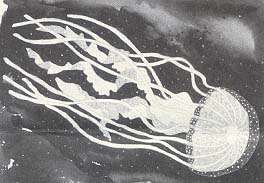
|
Archives:
Spring / Summer 1999 Table
of Contents The airport isn’t just for flying anymore. Thanks to the collaborative efforts of a Somerville artist, Wellesley College professors and students, and funding from the Massachusetts Port Authority, travelers passing through Boston’s Logan Airport are now greeted by full-color renderings of native sea creatures within the pedestrian walkways linking airport terminals. And, if all goes according to plan, multimedia exhibits designed to increase public appreciation for and awareness of New England’s marine life will soon follow.
The collaboration represents
a departure from tradition for internationally recognized artist
Jane Goldman. Instead of exhibiting her latest creation in an art
gallery, Goldman is displaying art for millions to see, indefinitely,
at Logan Airport. The walkways are fabricated in terrazzo, a mosaic-like medium that incorporates marble chips in a concrete base. When complete, the project will stretch the length of nearly ten football fields and feature over 80 species and six habitats of the Northwest Atlantic. In addition, several fish species from the world’s oceans will be featured in the international terminal walkway. Recently, the completion of a walkway linking Terminals A and E was celebrated with an official opening sponsored by MassPort and Cambridge Seven Associates, Inc., the designers of the pedestrian walkways. With 25 million people traveling through Logan Airport each year, MassPort’s $2.3 million investment in the artwork posed "a remarkable investment upon which to build a multimedia public science exhibit," explains Marianne Moore, an aquatic ecologist and professor of biology at Wellesley College. "Having an educational complement to the artwork seemed like something unusual that would captivate the public," Moore recalls. She mentioned the idea to some of her students. "One student in my marine biology class [Myna Joseph] was also taking Professor Metaxas’ multimedia class. It was she who came up with the idea for a multimedia project." The student has since graduated, but her ideas were the basis for a proposal, funded by the WHOI and MIT Sea Grant programs, to compile background information for a multi-million dollar National Science Foundation (NSF) proposal, to develop and test a prototype exhibit using the Boston Museum of Science’s Test Tube, and to pay for front-end evaluation at the airport conducted by Moore and her students. Student involvement in the project continues, says Moore, adding that students "have had fantastic ideas" for the multimedia project. If all the funding pieces come together, installation of the multimedia exhibits should take place in January 2001. Additional ideas have come from the New England Aquarium (NEAq). "New England Aquarium has been a fantastic collaborator," says Moore. NEAq will spearhead the public outreach endeavor using a multifaceted approach starting this year. At the recent artwork opening, NEAq brought its traveling tidepool tank to the airport. "They are interested in ‘inheriting’ the marine multimedia exhibit to keep it going," says Moore, who will work with the Aquarium to set up a task force to plan for long-term funding and maintenance of the exhibit. NEAq director of education Billy Spitzer would like to see the Logan multimedia project tied in to a planned NEAq exhibit on bio-diversity. One idea is to issue Aquarium visitors a passport. "The biodiversity exhibit will use islands to convey the concept of biodiversity," explains Moore, "and each island visited would be good for a passport stamp. The final stamp would be issued at the Logan exhibit." The passport idea goes beyond the exhibits, says Moore. "We’d like to have people take it home and continue learning and having fun with it. It’s possible there could be classroom involvement as well," she says. The concept of using nontraditional settings for public science exhibits is fairly new. A similar, NSF-funded exhibit on weather, titled "Thunderstorm Detectives" was installed at Douglas International Airport in Charlotte, N.C. Evaluation of the project revealed that one-third of the people walking through the exhibit area stopped to investigate. At Logan, using conservative estimates, 2.5—3.7 million people will likely interact with the exhibit, according to Moore. Studies show that one out of every three airport visitors has never visited a science museum or aquarium, a finding backed up by the evaluation conducted at Logan last July. Moore believes that this statistic, combined with the fact that people in airports generally have time to spare, provides evidence that "an airport exhibit has the potential to reach a broader audience than one at a museum or aquarium, because airport exhibits are likely to engage some people who never, or infrequently, enter museums or aquaria." So next time you head off to Logan for a flight, get there early. After you check your luggage, enjoy a scenic stroll between terminals while getting a realistic glimpse at local marine life depicted in terrazzo. It’s science where you’d least expect it. To learn more about the Logan Multimedia project, visit the web site: http://www.wellesley. edu/CS/Logan/multimedia.html
|
